Portable ladders are used for access to the attic, harvesting trees, performing repairs at a height. Many people make a ladder out of wood with their own hands, because the process is simple and does not require special qualifications. They make ladders, sliding systems, simple structures, while the products have different heights and widths. The parameters are regulated by the regulatory documents GOST 26.887 - 1988 and GOST 24.258 - 1988.
Design features and device
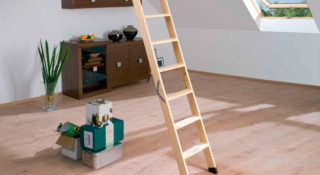
Portable ladders should be lightweight. As a rule, preference is given to wood as a lightweight and structurally convenient material.
There are certain requirements for the device and dimensions:
- the height of the product should not exceed 5 m, with a size of more than 1.3 m, additional fasteners are arranged;
- every 2 meters, as well as at the level of the lower and upper steps, it is necessary to install the bowstring ties;
- for the convenience of lifting, the gap between the treads is made 30 - 35 cm;
- the steps are not attached outside the girders, but are placed in specially provided recesses;
- stairs are made at least 40 mm between the bowstrings so that a person can pass;
- the structure must have an angle of 65 - 70 °;
- the lifting device must be sanded so that there are no burrs and sharp edges.
Of all the mobile varieties, ladders are among the most common. They are appreciated for the low cost of materials for manufacturing and stability during work. Additionally, hooks are provided at the top to secure the structure. The wood is chosen so that transverse cracks are not observed on it, longitudinal cracks are not deeper than 5 mm, and do not exceed 15 cm in length.
A load capacity test (for industrial versions) is carried out every year. Each stage is alternately loaded with a load that weighs 120 kg. The lower ends of the vertical girders are protected with rubber stickers or metal studs made of reinforcement with a diameter of 10-16 mm are placed (for installation on loose ground).
Varieties of ladders
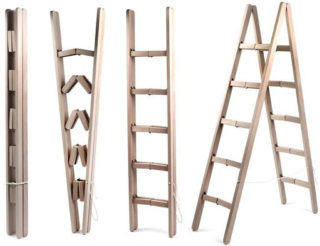
In fact, a ladder made of wood consists of two vertical posts, on which horizontal rungs are fixed. Modern designs differ in qualities and technical characteristics:
- simple;
- retractable;
- foldable.
Everyone chooses a universal lift for himself based on the direction of use.
A ready-made ladder can be purchased at the store. They buy aluminum products more often. Their cost is high, so it makes sense to assemble the ladder with your own hands. Steel and aluminum parts are not used, wood is used, which is cheaper than metal.
With an increase in height, more steps are made, one-section schemes are made taking into account human anthropometry, for example, the growth of the owner. Such structures are never screwed, only with a straight arrangement of support bars. The devices can stand freely, lean on the wall obliquely or vertically, and be hinged.
Simple
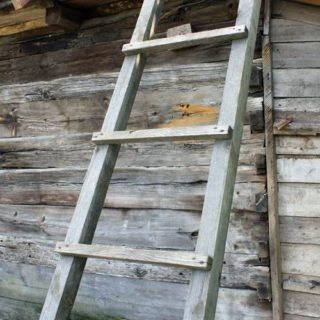
The ladder needs support for stable standing (wall, pillar, tree trunk). There are simple single-layer ladders that are hung on vertical rails or, for example, on the ridge of a roof to carry out roof repairs.There are buildings that reach 20 m in height, they are used in non-standard situations or in unforeseen circumstances, for example, a fire.
A simple version provides for the assembly of the ladder without hinges and retractable structures. The frame consists of two vertical girders (50 x 75 mm), on which transverse wooden plates are fixed. Transverse reinforcements are used to tighten the strings (beams). The surface of the steps is made corrugated or longitudinal protruding strips are stuffed.
A drawing and calculation for such a staircase can be omitted, since the structure belongs to the category of elementary ones. On vertical runs, cuts are made to half the thickness of the timber, into which the crossbars are inserted. The steps sit firmly in the recesses so that their edges are flush with the outside.
For stairs above 3 m, bars of 50 x 100 mm are used. Such a product has significant weight, its structure has its own characteristics. The bottom is always wider than the top to provide additional stability. At the top of the ladder for the roof, parts are made, the slope of which corresponds to the slope of the roof slopes, so that they can tightly cling to the ridge.
Retractable
The appearance of such products resembles a standard design, but they differ in that they can be adjusted in height. The structure includes several pull-out sections.
The segments are extended using guide rollers, which are made of steel. Previously, such elements were used to remove ladders on fire trucks, but now the devices have found application in the private sector.
Types of retractable structures:
- transformers;
- telescopic.
The lifting height of the person can be set at the required level. At the same time, retractable ladders are mobile and lightweight. The disadvantage is the low stability of the ladder if it is open to its full height.
The use of retractable ladders belongs to the category of high-rise work with an increased degree of danger, therefore, increased reliability requirements are imposed on the assembly.
The places where the crossbars are attached to the bowstring are treated with antiseptics and anticorrosive compounds.
Folding
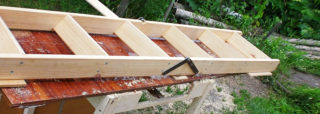
Folding options differ from straight ones in that several sections in them are held together by hinges, but do not extend in height, but unfold. When assembled, the model is a compact unit; when disassembled, it becomes a high staircase. Such products are often fixed permanently for lifting to the attic. The owner pulls the release of the ladder, it unfolds and turns into a convenient ladder.
Foldable products are difficult to design so that all parts interact flawlessly. To the cost of wood, standard screeds and hardware, movable metal assemblies of a complex structure are added, which have a high price. Folding models require precise assembly and complex installation.
Folding options include ladders - these are the simplest models for which cheap standard hinges are installed.
Folding ladders are made in the form of a ladder with a support frame on the other side or in the form of a double ladder on both sides.
The reliability of the ladder depends on the angle of its opening, the larger it is, the more stable the structure.
The folding varieties include rope ladders, where the steps are made of wood, and ropes are placed instead of strings.
Advantages and disadvantages of wooden stairs
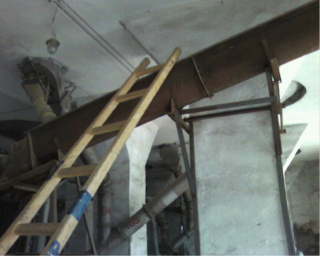
Due to their low weight, wooden models can be carried effortlessly, so the place of work can be accessible from all sides. The cost of wood is lower than metal, working with wood does not require special skills - anyone who sets a goal can make a mobile lifting device. For standard models, it is enough to be able to use a saw, a plane, a chisel.
For folding ladders to the attic in the living area, you can choose the pattern and texture of the material, which is combined with other interior decoration.
No ice builds up on wood steps, unlike metal options, so the risk of falling is reduced.
Disadvantages of wooden stairs:
- structures have a small margin of safety and low carrying capacity - most products cannot withstand a mass of over 200 kg;
- due to the small support area, such ladders are not very stable;
- there are no railings in portable models, so it is inconvenient to go up and down.
Wood is a capricious material and requires regular maintenance. At low humidity, the product can crack, so the surface is treated with protective agents. The boards serve for 15-20 years, depending on the intensity of use and load.
Necessary tools and materials for work
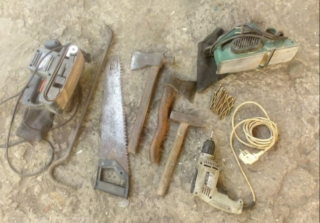
A simple design requires a hammer, saw and nails. A beautiful and durable design requires additional tools and processing tools:
- hammer for driving nails;
- electric drill;
- handy saw for precise cuts and saws on the sidewalls;
- chisel, ax, plane, file;
- brush or roller;
- impregnation against fungus, mold, corrosion, wood glue or PVA;
- topcoat paint, stain;
- sandpaper for roughing and final grinding (no. 40, 60, 120);
- tape measure, ruler, square, pencil, workbench.
A simple staircase is made by inexpensive pine, the material is not elastic, but strong enough. The durability of the product can be increased by using larch or birch.
DIY instructions
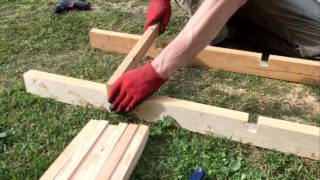
First, support sidewalls of the same length are prepared. They are planed with a plane and sanded with sandpaper until a smooth and even surface is obtained. A piece of wood is cut from one end of each upright at an angle of approximately 45 ° to ensure that the bottom stop is even. Bars and prepared boards for treads are treated with preservatives.
On a flat plane, lay out two runs in parallel so that there is a gap of 65 cm between them. They are fixed in this position.
Making a wooden staircase with your own hands:
- the notches are made at a distance of 35 cm from the bottom along the transverse marks with a step of 30 cm (step frequency);
- cuts are sawn through the marks to a depth of 20 mm;
- above the cut by 5 cm, chisel a step with a chisel, this is how they make places for fastening the boards-steps;
- the crossbars are placed in the resulting groove, fixed with a nail or self-tapping screw;
- if the staircase narrows upward, cut off the lateral parts of the transverse boards that go beyond the dimensions;
- for screeds, a pair of holes are drilled under the upper and lower steps in the body of the bowstring.
Studs with washers are placed in the holes of 10 mm and 2 nuts are placed at the top. Use wrenches to tighten. The finished product is treated with wood stain or painted with oil paint. Hooks are attached on top to work with the stand at an angle greater than 70 °.
Operating rules
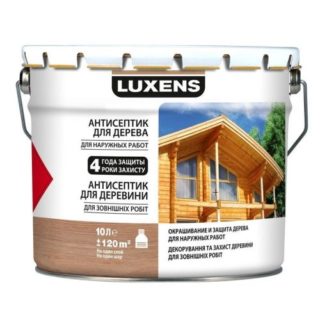
The finished staircase looks neat, but this look does not last long if the product is not impregnated with protective compounds or painted. Bacteria penetrate the wood fibers, rotting begins.
Wood pretreatment rules:
- the first layer of impregnation is applied and left for a couple of hours to dry;
- the second time they soak and also wait 2 hours;
- use varnish to get a beautiful look and shine. The product can be used after 2 days.
If the ladders are transported in cars, they are fixed in such a way as to prevent movement over the body and not to spoil the outer layer of paint. Before use, after a break, check the functionality of structural units and visually inspect for cracks or chips.
The ladder is placed against a flat, vertical and reliable surface, both upper ends must have a stop.
Once a year, you need to test the structure for strength. If the product does not pass the test, it is not used for work.








